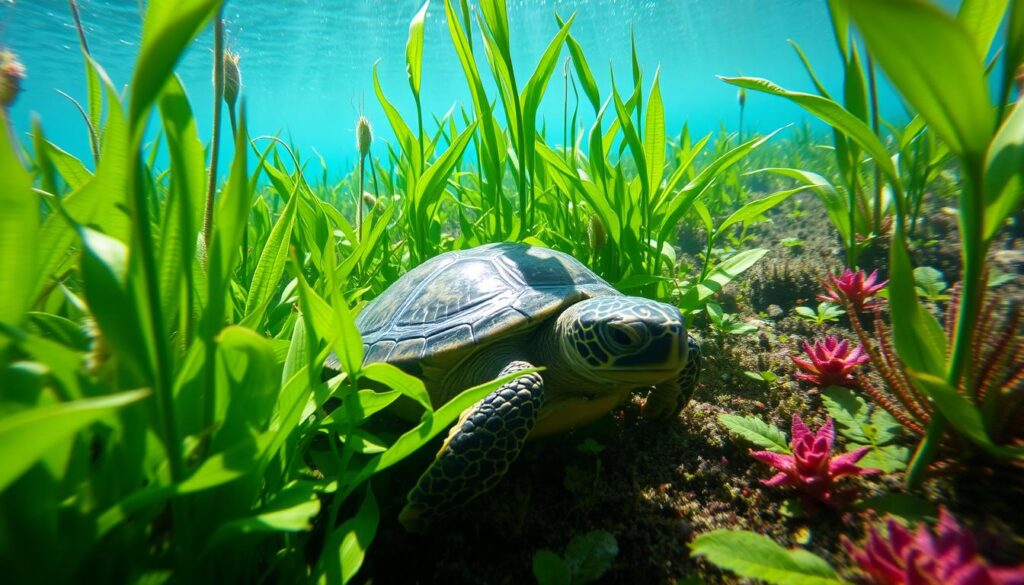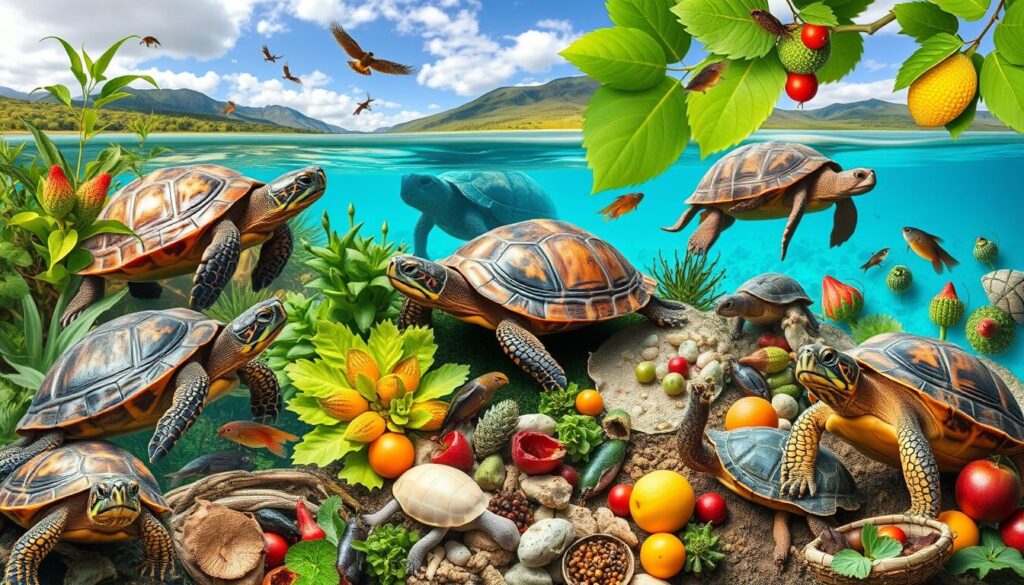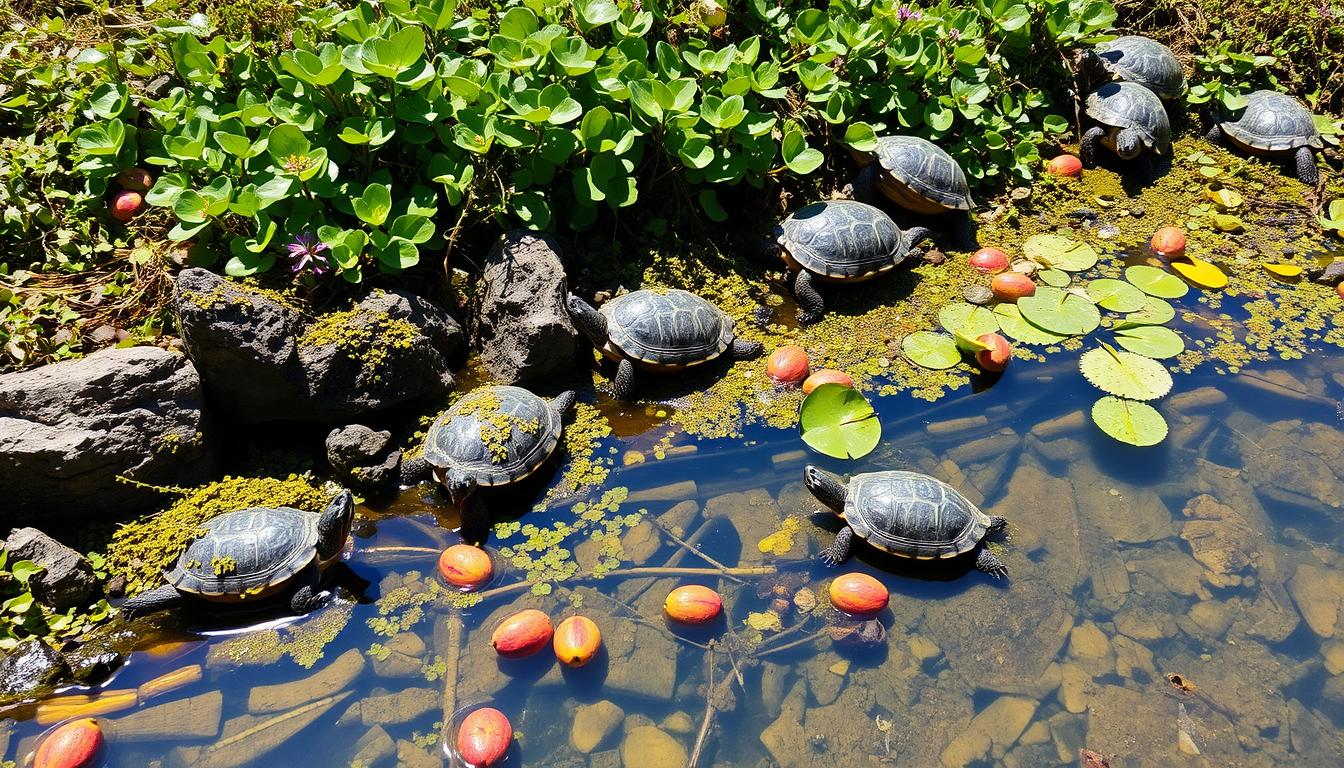Did you know wild turtles can eat up to 50% of their diet in plants? Their eating habits change a lot based on their species and where they live. Knowing what wild turtles eat helps us understand their ecosystems better and keep them healthy.
In this guide, we’ll look at how wild turtles eat naturally. We’ll cover what they eat, how their diet changes with the seasons, and how their environment affects their nutrition. By the end, you’ll see how fascinating and complex wild turtle nutrition is.
Table of Contents
Understanding Wild Turtle Species and Their Natural Habitats
The world is home to over 300 turtle species, each living in different places. From water to land, turtles have adapted to their homes in amazing ways. Knowing what they eat and where they live helps us understand their role in nature.
Aquatic Turtle Species
Aquatic turtles live in water, like ponds and lakes. They eat plants, fish, and insects. Their webbed feet and ability to stay underwater for a long time show how well they’ve adapted to life in the water.
Terrestrial Turtle Species
Terrestrial turtles live on land, in forests and grasslands. They mostly eat plants and berries. Their strong shells and special legs help them move around on land.
Semi-aquatic Turtle Species
Some turtles, like snapping turtles, live in both water and on land. They eat fish, plants, and even dead animals. Their ability to move between water and land makes them flexible in different environments.
Knowing what turtles eat and where they live is key to taking care of them. By understanding their unique traits, we can appreciate the complex life on our planet.
“Turtles are the living representatives of a group of reptiles that have existed on Earth for the past 220 million years.” – Turtle Conservancy
The Natural Diet of Wild Turtles in Different Ecosystems
The diet of wild turtles changes a lot based on where they live. Aquatic turtles, like the red-eared slider and painted turtle, mostly eat aquatic plants, insects, fish, and crustaceans. On the other hand, terrestrial turtles mostly eat plants, fruits, and sometimes insects. Sea turtles have unique diets, with some eating jellyfish and others eating seagrasses.
What food is available in different places affects how turtles eat and what they need to survive. This also shapes their behavior and how they make it through tough times. For example, pond turtles are omnivores, eating a wide range of foods like plants, algae, insects, and small animals. The seasons and where they live change what they eat, helping them stay healthy and reproduce.
It’s key to know about turtle omnivore habits, wild turtle food sources, and aquatic turtle foraging to help protect these amazing reptiles and keep their ecosystems balanced.
“The diversity of turtle species and their adaptations to various habitats is a testament to the resilience and importance of these reptiles in the natural world.”
What Do Wild Turtles Eat
Wild turtles eat different things based on their species and where they live. Some eat meat, while others prefer plants. This shows how well they can adapt to their food needs.
Carnivorous Diet Components
Carnivorous turtles, like many water-dwelling ones, hunt for food in the water. They eat fish, insects, crustaceans, and small amphibians. This diet gives them the proteins and fats they need to grow.
Herbivorous Food Sources
Herbivorous turtles, found on land, eat plants. They munch on water plants, algae, and fruits. This diet gives them vitamins, minerals, and carbs, helping them stay healthy.
Omnivorous Feeding Patterns
Omnivorous turtles, the most common type, eat both plants and animals. They enjoy leafy greens, veggies, insects, small fish, and amphibians. This mix of foods keeps them well-nourished.
The food choices of wild turtles depend on their species, age, and what’s available in their homes. Knowing what they eat helps us protect them and keep their populations healthy.
“A diverse diet is the key to a healthy, thriving turtle population in the wild.”
Aquatic Vegetation and Plant Matter in Turtle Diets
For many wild turtles, eating aquatic plants is key. These plants give them important nutrients. They help meet the dietary needs of both aquatic and semi-aquatic turtles.
Wild turtles eat water lilies, duckweed, and other plants found in pet stores. They also enjoy dark, leafy greens like collard greens and mustard greens. These are good for both wild and captive turtles.
Adding shredded carrots, squash, and green beans to their diet is also good. It makes sure they get a mix of vitamins, minerals, and other nutrients. Offering a variety of plants is important for their health and well-being.
| Aquatic Plant | Nutritional Benefits | Prevalence in Turtle Diets |
|---|---|---|
| Water Lilies | High in vitamins A and C, as well as calcium and other minerals | Commonly consumed by both aquatic and semi-aquatic turtle species |
| Duckweed | Rich in protein, vitamins, and essential fatty acids | A staple food source for many freshwater turtle populations |
| Aquarium Plants | Provide a diverse array of nutrients and fiber | Frequently incorporated into the diets of captive and rehabilitated turtles |
Understanding the importance of freshwater turtle vegetation helps us see their foraging habits. It shows how vital plant-based foods are for their health. A varied diet is key to keeping these reptiles healthy for a long time.

Protein Sources and Live Prey for Wild Turtles
Wild turtles eat both plants and animals. They need protein from live prey to stay healthy. They hunt and forage for food, showing their hunting skills.
Fish and Aquatic Creatures
Red-eared sliders and other freshwater turtles eat small fish and crustaceans. They get important proteins and nutrients from these foods. This helps them grow and stay healthy.
Insects and Invertebrates
Insects and invertebrates are big parts of a wild turtle’s diet. They eat earthworms, waxworms, and snails. These foods are full of nutrients, especially for young turtles.
Small Amphibians and Reptiles
Some turtles, like box turtles, eat small amphibians and reptiles. While not common, these foods add variety to their diet. They provide valuable nutrients.
It’s safer to feed pet turtles with commercial foods instead of wild prey. This avoids the risk of parasites. Foods like feeder fish, insects, and frozen-thawed rodents are good alternatives.
“Feeding wild turtles is a delicate balance, as they require a diverse diet to thrive. Understanding their natural feeding patterns and preferences is crucial for providing them with the best possible care, whether in captivity or in their native habitats.”
Seasonal Changes in Wild Turtle Feeding Habits
Wild turtles eat differently throughout the year. In spring and summer, they find lots of insects, crustaceans, and plants. These months help them store energy for the cold seasons.
In fall and winter, food gets scarce. Turtles then eat more plants like leaves and water lilies. Some even hibernate, using stored energy to get through the cold.
Aquatic turtles, like pond sliders, eat insects, crayfish, and small fish in warm weather. But when it gets cold, they eat less and focus on plants like water lilies.
Terrestrial turtles, like box turtles, hunt for insects and fruits in spring and summer. As winter comes, they eat more plants like leaves and vegetables.
| Turtle Species | Spring/Summer Diet | Fall/Winter Diet |
|---|---|---|
| Aquatic Turtles | Aquatic insects, crayfish, small fish | Aquatic vegetation (water lilies, duckweed) |
| Terrestrial Turtles | Insects, bugs, fruits, berries | Leafy greens, vegetables |
Knowing how turtles’ diets change with the seasons is key. It helps keep them healthy in the wild or in captivity. By adjusting their eating habits, turtles stay balanced and thrive.
Feeding Patterns of Young Wild Turtles
Young wild turtles have different eating needs than adults. Hatchlings and juveniles need more protein to grow fast. They eat insects, small fish, and tadpoles.
Hatchling Dietary Requirements
Hatchling turtles need special food to grow and survive. They should eat every day. Their diet should include insects and small fish.
Juvenile Growth and Nutrition
As young turtles grow, their diet changes. They still need protein but also eat more plants. This includes aquatic plants, fruits, and vegetables.
In captivity, feed young turtles daily. Adults can eat every two to three days. This meets their hatchling turtle diet and turtle species dietary needs.
“Proper nutrition is crucial for the healthy development of young wild turtles, as it lays the foundation for their future growth and survival.”
Knowing what young turtles need to eat is key. It helps them stay healthy and supports their survival. This is important for these amazing creatures.
Regional Variations in Wild Turtle Diets
The diets of wild turtles change a lot based on where they live. Turtles in warm places eat a wide range of fruits and plants all year. But, turtles in cooler areas have to adjust their eating habits with the seasons.
Coastal turtles eat more sea creatures, while freshwater turtles stick to plants and animals in the water. This shows how different their diets can be.
For example, angulate tortoises in South Africa and Namibia help spread seeds. They can grow up to 12 inches long and live for about 30 years. On the other hand, snapping turtles in North America can live up to 47 years. Their diet changes with the seasons, from insects to fish and plants.
Knowing how different turtles eat is key for helping them. It helps us care for turtles that are rescued or need help. By matching their food to their home, we can help them stay healthy and live long lives.

“Turtles are the living links to the past, and we have the opportunity to make sure they are part of our future.”
It’s important to give turtles the right food for their health. By learning about their eating habits, we can help protect these amazing animals. This way, we can ensure they continue to thrive in our world.
The Role of Minerals and Vitamins in Wild Turtle Nutrition
Keeping wild turtles healthy means they need the right minerals and vitamins. These nutrients are key for their turtle species health, from their dietary needs to their turtle diet.
Calcium is vital for turtles. It helps grow and keep their shells and bones strong. In the wild, they get calcium from plants, small fish, and invertebrates they eat.
Vitamin D3 helps them use calcium. Turtles make vitamin D3 when they get UVB light from the sun. But in places with little sunlight, they might need extra vitamin D3.
Wild turtles also need other vitamins and minerals like:
- Vitamin A for their eyes and immune system
- B vitamins for energy and health
- Phosphorus for bones and shells
- Magnesium for muscles and nerves
In the wild, turtles eat a variety of foods to get what they need. But in captivity, they might need extra help to stay healthy.
“Providing a complete diet alongside special turtle food and calcium supplements ensures that tortoises receive all the necessary nutrients for a healthy shell and strong bones.”
Minerals and vitamins are very important for wild turtles. Knowing what each turtle species needs helps them stay healthy in their natural homes.
Environmental Factors Affecting Turtle Feeding Behavior
Turtles’ eating habits change based on their environment. Temperature is key, as it affects their metabolism and how active they are. Warmer temperatures make turtles eat more because their bodies work better.
Colder temperatures, however, make them eat less. This is because they need to save energy to stay warm.
Habitat Availability
The type of habitat turtles live in also matters. The food they find depends on their environment. Changes in water levels, pollution, or habitat loss can affect their food supply.
This forces turtles to change how they eat to survive.
Food Source Accessibility
How easy it is for turtles to find food is also important. Changes in seasons and climate can change where food is found. This makes turtles adjust their eating habits.
Knowing these factors helps in protecting turtles. It ensures they have what they need to live and thrive.

